University Report: Evaluation of a WHS Training Programme
VerifiedAdded on 2023/06/04
|16
|2496
|247
Report
AI Summary
This report provides a comprehensive evaluation of a WHS (Work Health and Safety) training program. It begins with a detailed training program outline, addressing identified WHS training needs, legislative requirements, and the incorporation of coaching and mentoring principles. The report analyzes how adult learning principles were integrated into the training, identifies key participants, and describes the structure and content of the coaching/mentoring program. It also covers the approximate costs of the training program and the reporting mechanisms used to measure its effectiveness. Furthermore, the report includes a case study with an incident report, analyzing the incident details, witness accounts, and the actions taken. The report references relevant legislation, guidelines, and academic literature to support its findings and recommendations. Overall, the report offers a practical assessment of a WHS training program, providing valuable insights into its design, implementation, and evaluation.
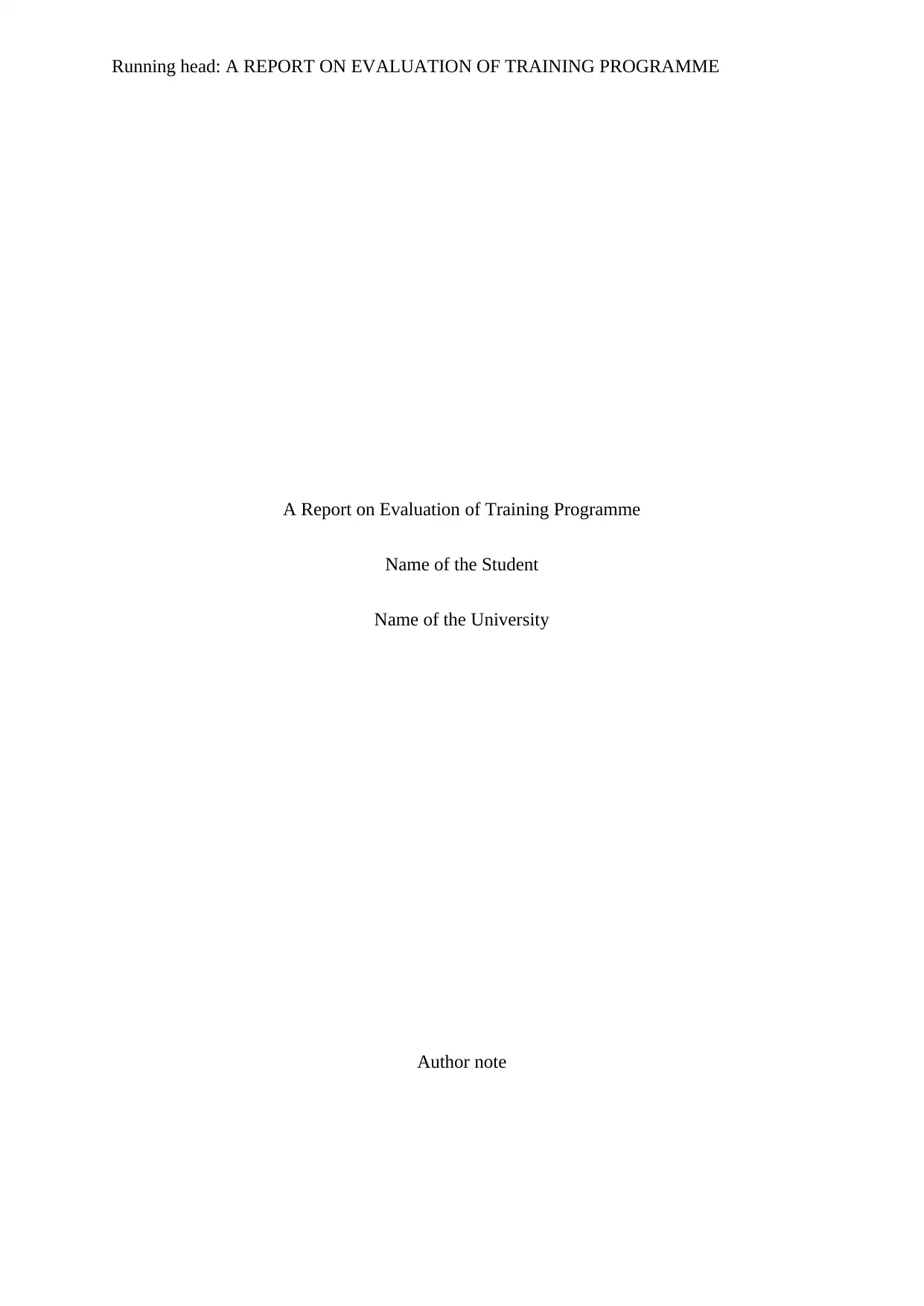
Running head: A REPORT ON EVALUATION OF TRAINING PROGRAMME
A Report on Evaluation of Training Programme
Name of the Student
Name of the University
Author note
A Report on Evaluation of Training Programme
Name of the Student
Name of the University
Author note
Paraphrase This Document
Need a fresh take? Get an instant paraphrase of this document with our AI Paraphraser
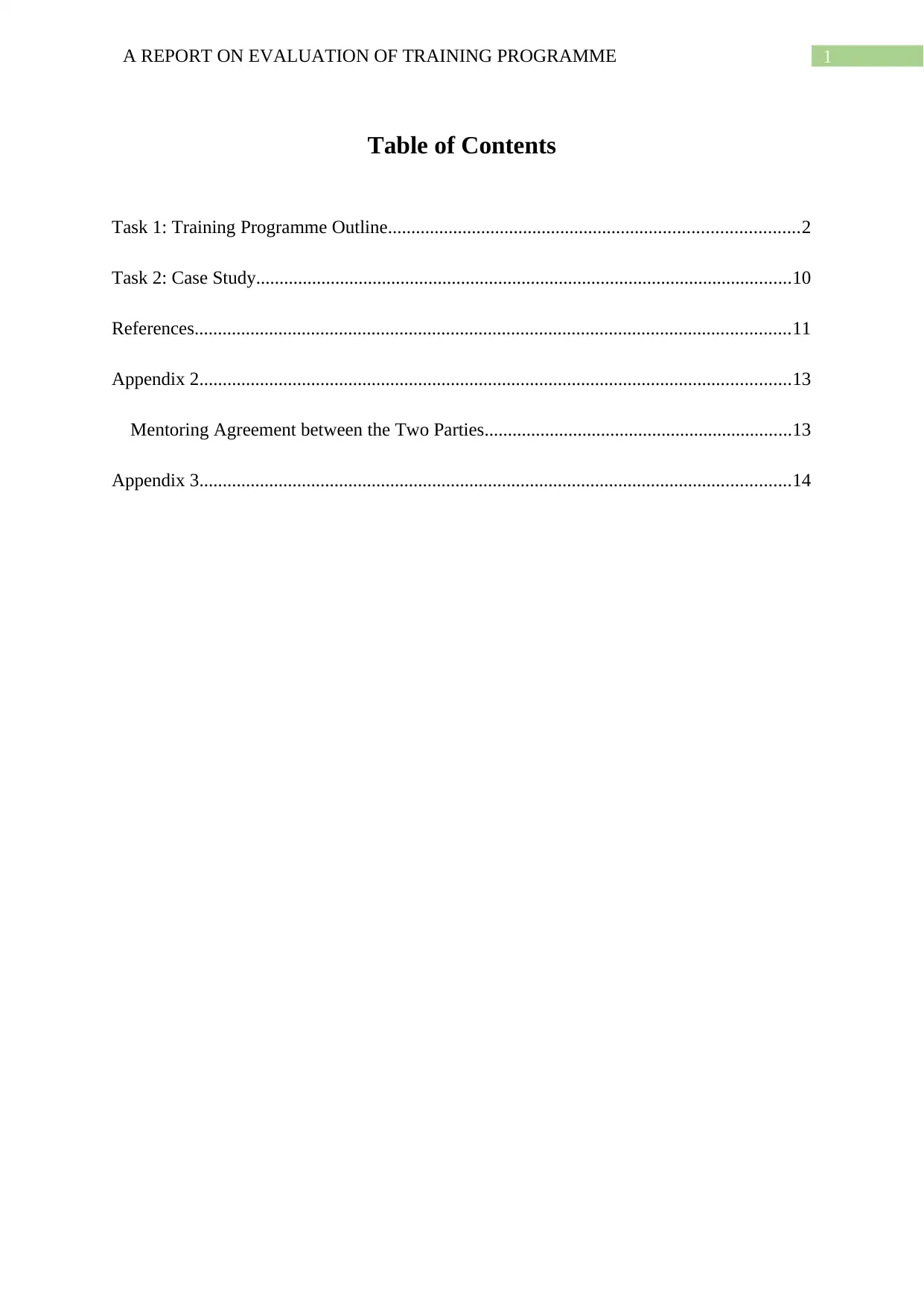
1A REPORT ON EVALUATION OF TRAINING PROGRAMME
Table of Contents
Task 1: Training Programme Outline........................................................................................2
Task 2: Case Study...................................................................................................................10
References................................................................................................................................11
Appendix 2...............................................................................................................................13
Mentoring Agreement between the Two Parties..................................................................13
Appendix 3...............................................................................................................................14
Table of Contents
Task 1: Training Programme Outline........................................................................................2
Task 2: Case Study...................................................................................................................10
References................................................................................................................................11
Appendix 2...............................................................................................................................13
Mentoring Agreement between the Two Parties..................................................................13
Appendix 3...............................................................................................................................14
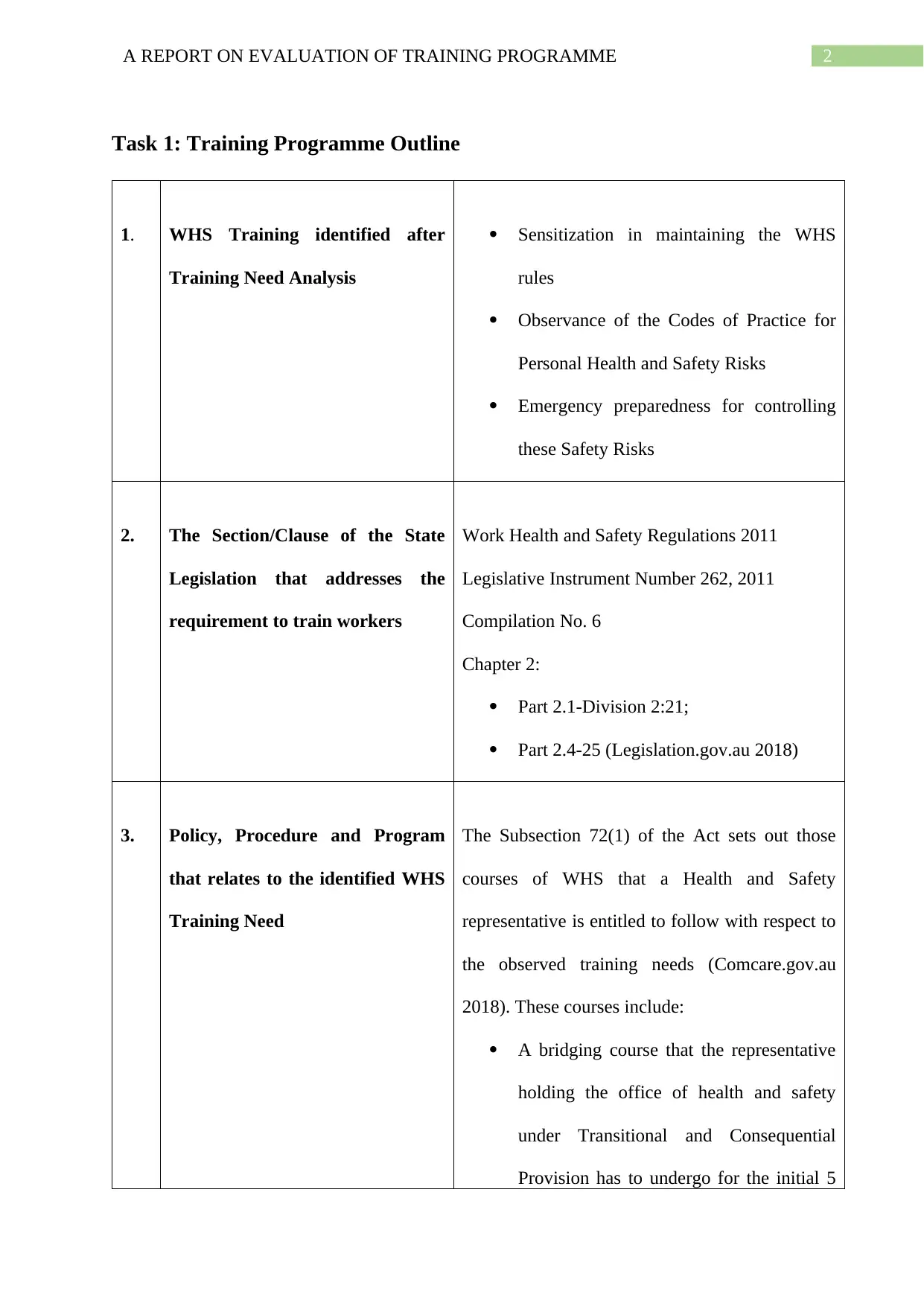
2A REPORT ON EVALUATION OF TRAINING PROGRAMME
Task 1: Training Programme Outline
1. WHS Training identified after
Training Need Analysis
Sensitization in maintaining the WHS
rules
Observance of the Codes of Practice for
Personal Health and Safety Risks
Emergency preparedness for controlling
these Safety Risks
2. The Section/Clause of the State
Legislation that addresses the
requirement to train workers
Work Health and Safety Regulations 2011
Legislative Instrument Number 262, 2011
Compilation No. 6
Chapter 2:
Part 2.1-Division 2:21;
Part 2.4-25 (Legislation.gov.au 2018)
3. Policy, Procedure and Program
that relates to the identified WHS
Training Need
The Subsection 72(1) of the Act sets out those
courses of WHS that a Health and Safety
representative is entitled to follow with respect to
the observed training needs (Comcare.gov.au
2018). These courses include:
A bridging course that the representative
holding the office of health and safety
under Transitional and Consequential
Provision has to undergo for the initial 5
Task 1: Training Programme Outline
1. WHS Training identified after
Training Need Analysis
Sensitization in maintaining the WHS
rules
Observance of the Codes of Practice for
Personal Health and Safety Risks
Emergency preparedness for controlling
these Safety Risks
2. The Section/Clause of the State
Legislation that addresses the
requirement to train workers
Work Health and Safety Regulations 2011
Legislative Instrument Number 262, 2011
Compilation No. 6
Chapter 2:
Part 2.1-Division 2:21;
Part 2.4-25 (Legislation.gov.au 2018)
3. Policy, Procedure and Program
that relates to the identified WHS
Training Need
The Subsection 72(1) of the Act sets out those
courses of WHS that a Health and Safety
representative is entitled to follow with respect to
the observed training needs (Comcare.gov.au
2018). These courses include:
A bridging course that the representative
holding the office of health and safety
under Transitional and Consequential
Provision has to undergo for the initial 5
⊘ This is a preview!⊘
Do you want full access?
Subscribe today to unlock all pages.

Trusted by 1+ million students worldwide
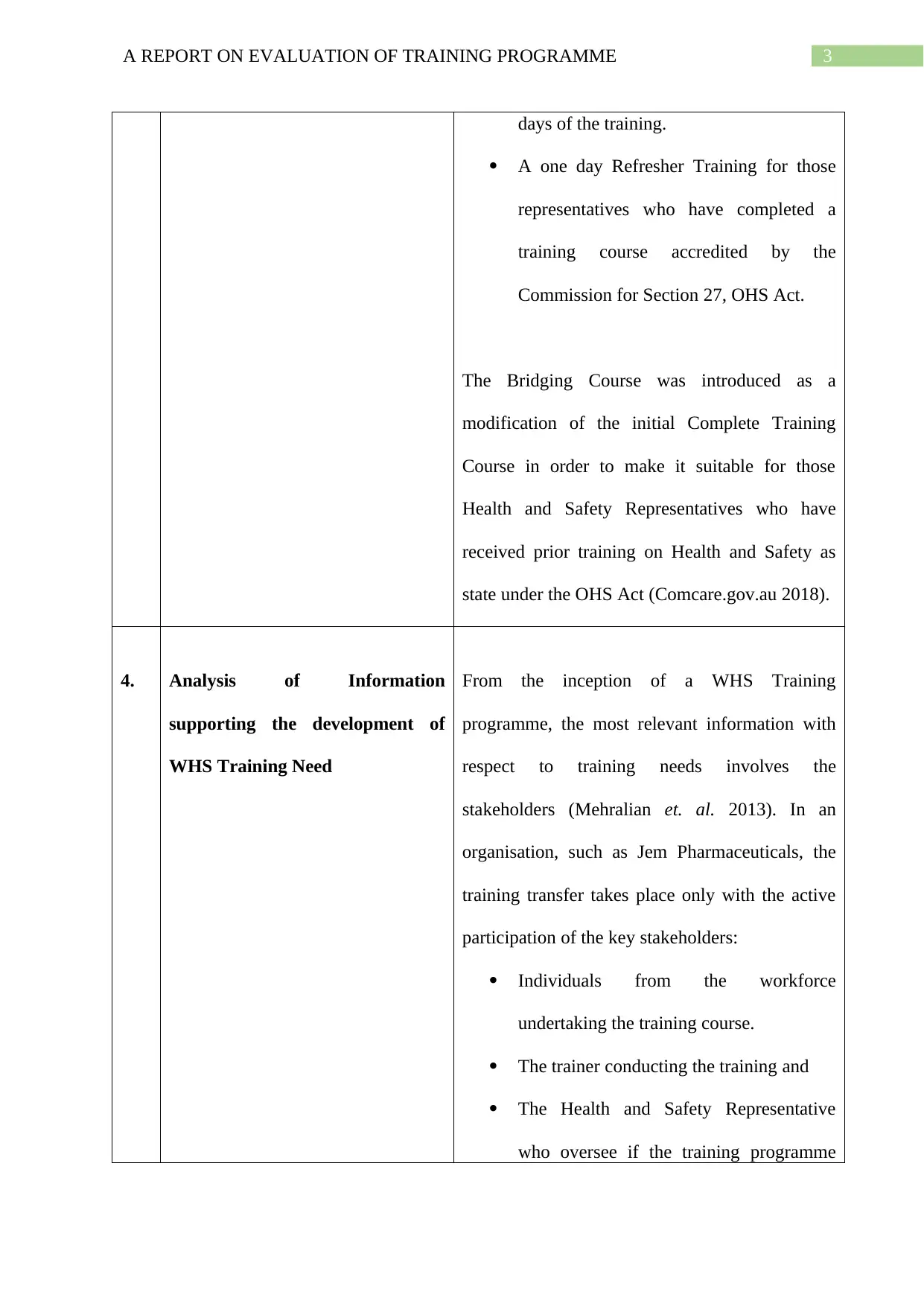
3A REPORT ON EVALUATION OF TRAINING PROGRAMME
days of the training.
A one day Refresher Training for those
representatives who have completed a
training course accredited by the
Commission for Section 27, OHS Act.
The Bridging Course was introduced as a
modification of the initial Complete Training
Course in order to make it suitable for those
Health and Safety Representatives who have
received prior training on Health and Safety as
state under the OHS Act (Comcare.gov.au 2018).
4. Analysis of Information
supporting the development of
WHS Training Need
From the inception of a WHS Training
programme, the most relevant information with
respect to training needs involves the
stakeholders (Mehralian et. al. 2013). In an
organisation, such as Jem Pharmaceuticals, the
training transfer takes place only with the active
participation of the key stakeholders:
Individuals from the workforce
undertaking the training course.
The trainer conducting the training and
The Health and Safety Representative
who oversee if the training programme
days of the training.
A one day Refresher Training for those
representatives who have completed a
training course accredited by the
Commission for Section 27, OHS Act.
The Bridging Course was introduced as a
modification of the initial Complete Training
Course in order to make it suitable for those
Health and Safety Representatives who have
received prior training on Health and Safety as
state under the OHS Act (Comcare.gov.au 2018).
4. Analysis of Information
supporting the development of
WHS Training Need
From the inception of a WHS Training
programme, the most relevant information with
respect to training needs involves the
stakeholders (Mehralian et. al. 2013). In an
organisation, such as Jem Pharmaceuticals, the
training transfer takes place only with the active
participation of the key stakeholders:
Individuals from the workforce
undertaking the training course.
The trainer conducting the training and
The Health and Safety Representative
who oversee if the training programme
Paraphrase This Document
Need a fresh take? Get an instant paraphrase of this document with our AI Paraphraser
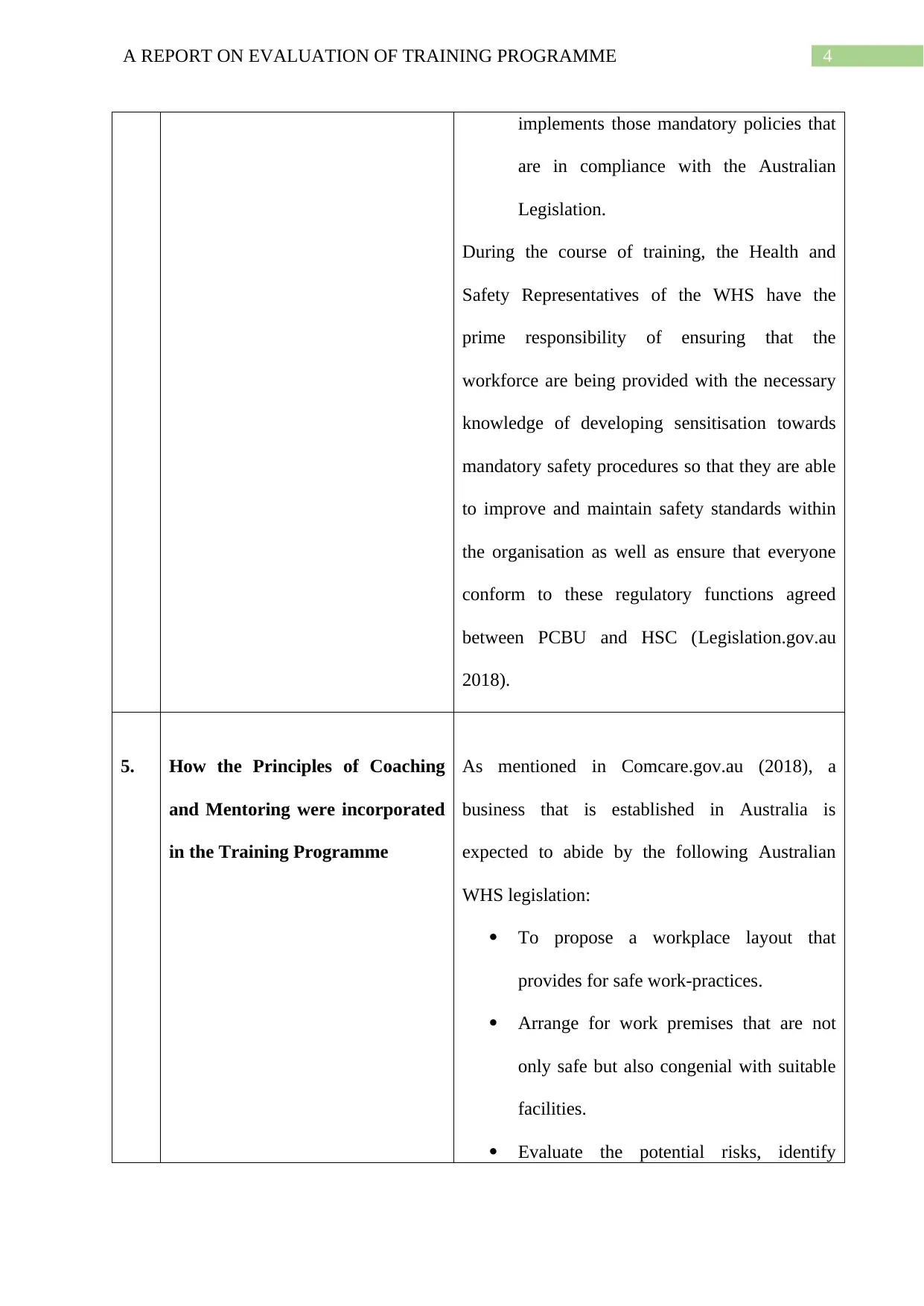
4A REPORT ON EVALUATION OF TRAINING PROGRAMME
implements those mandatory policies that
are in compliance with the Australian
Legislation.
During the course of training, the Health and
Safety Representatives of the WHS have the
prime responsibility of ensuring that the
workforce are being provided with the necessary
knowledge of developing sensitisation towards
mandatory safety procedures so that they are able
to improve and maintain safety standards within
the organisation as well as ensure that everyone
conform to these regulatory functions agreed
between PCBU and HSC (Legislation.gov.au
2018).
5. How the Principles of Coaching
and Mentoring were incorporated
in the Training Programme
As mentioned in Comcare.gov.au (2018), a
business that is established in Australia is
expected to abide by the following Australian
WHS legislation:
To propose a workplace layout that
provides for safe work-practices.
Arrange for work premises that are not
only safe but also congenial with suitable
facilities.
Evaluate the potential risks, identify
implements those mandatory policies that
are in compliance with the Australian
Legislation.
During the course of training, the Health and
Safety Representatives of the WHS have the
prime responsibility of ensuring that the
workforce are being provided with the necessary
knowledge of developing sensitisation towards
mandatory safety procedures so that they are able
to improve and maintain safety standards within
the organisation as well as ensure that everyone
conform to these regulatory functions agreed
between PCBU and HSC (Legislation.gov.au
2018).
5. How the Principles of Coaching
and Mentoring were incorporated
in the Training Programme
As mentioned in Comcare.gov.au (2018), a
business that is established in Australia is
expected to abide by the following Australian
WHS legislation:
To propose a workplace layout that
provides for safe work-practices.
Arrange for work premises that are not
only safe but also congenial with suitable
facilities.
Evaluate the potential risks, identify
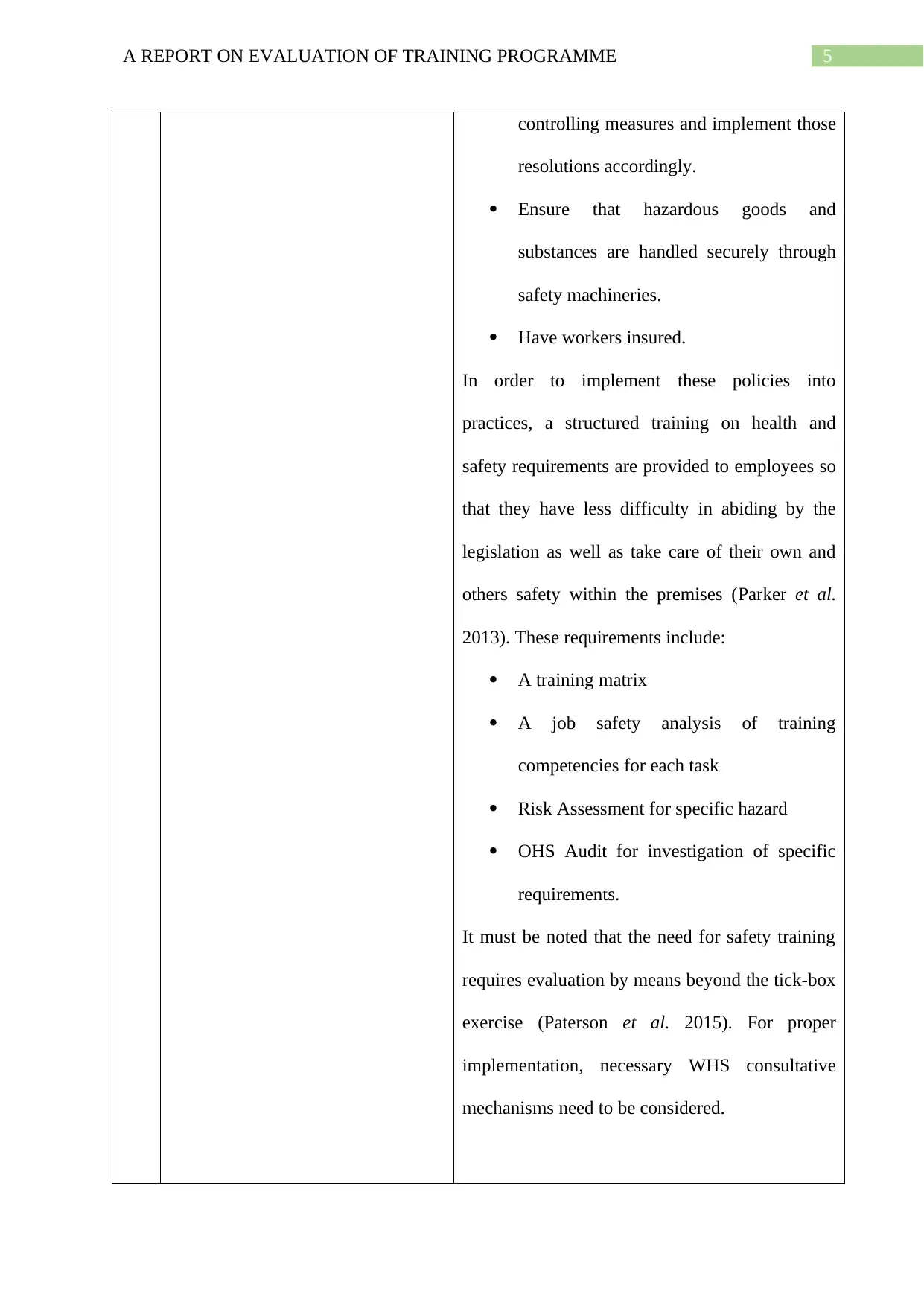
5A REPORT ON EVALUATION OF TRAINING PROGRAMME
controlling measures and implement those
resolutions accordingly.
Ensure that hazardous goods and
substances are handled securely through
safety machineries.
Have workers insured.
In order to implement these policies into
practices, a structured training on health and
safety requirements are provided to employees so
that they have less difficulty in abiding by the
legislation as well as take care of their own and
others safety within the premises (Parker et al.
2013). These requirements include:
A training matrix
A job safety analysis of training
competencies for each task
Risk Assessment for specific hazard
OHS Audit for investigation of specific
requirements.
It must be noted that the need for safety training
requires evaluation by means beyond the tick-box
exercise (Paterson et al. 2015). For proper
implementation, necessary WHS consultative
mechanisms need to be considered.
controlling measures and implement those
resolutions accordingly.
Ensure that hazardous goods and
substances are handled securely through
safety machineries.
Have workers insured.
In order to implement these policies into
practices, a structured training on health and
safety requirements are provided to employees so
that they have less difficulty in abiding by the
legislation as well as take care of their own and
others safety within the premises (Parker et al.
2013). These requirements include:
A training matrix
A job safety analysis of training
competencies for each task
Risk Assessment for specific hazard
OHS Audit for investigation of specific
requirements.
It must be noted that the need for safety training
requires evaluation by means beyond the tick-box
exercise (Paterson et al. 2015). For proper
implementation, necessary WHS consultative
mechanisms need to be considered.
⊘ This is a preview!⊘
Do you want full access?
Subscribe today to unlock all pages.

Trusted by 1+ million students worldwide
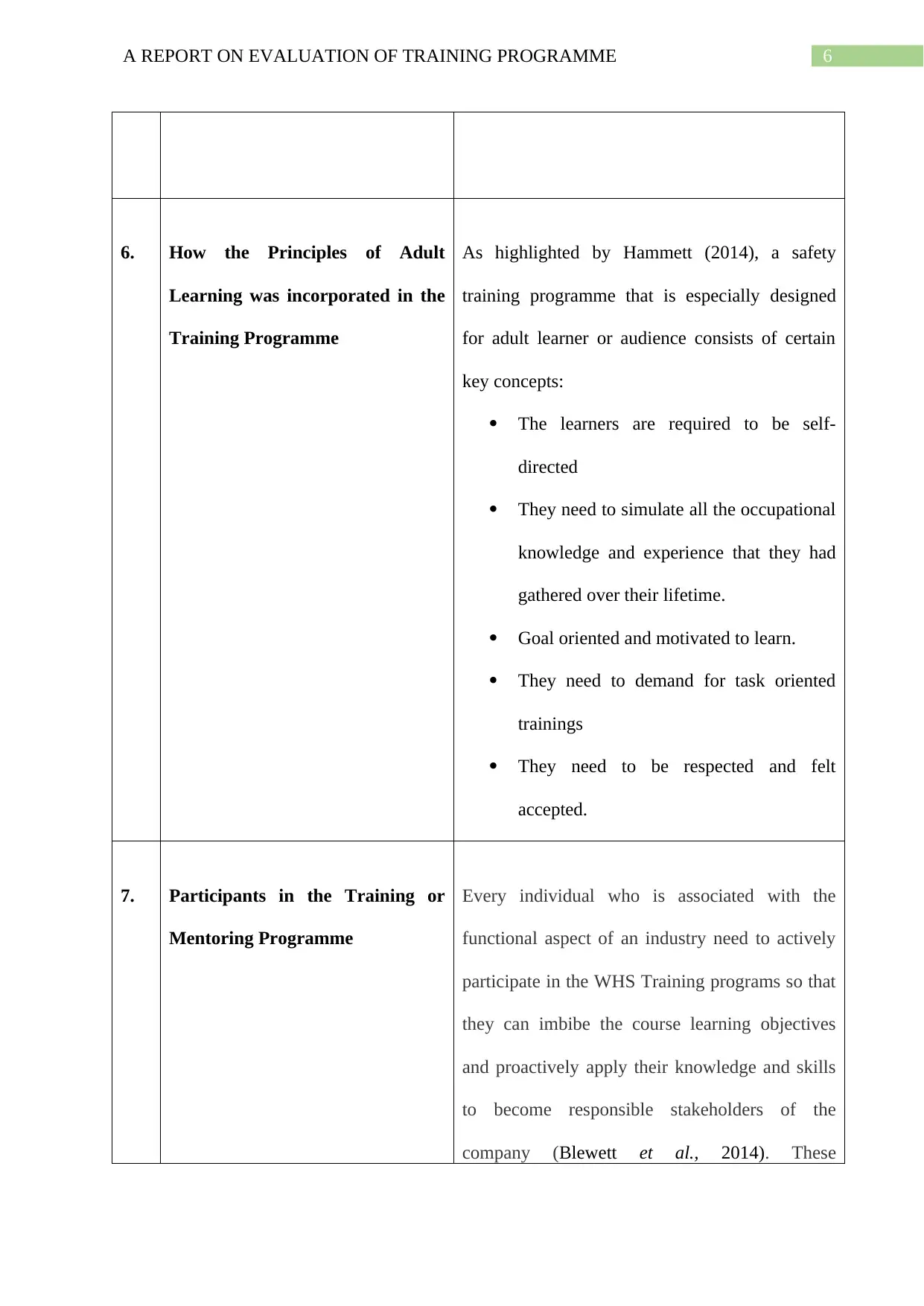
6A REPORT ON EVALUATION OF TRAINING PROGRAMME
6. How the Principles of Adult
Learning was incorporated in the
Training Programme
As highlighted by Hammett (2014), a safety
training programme that is especially designed
for adult learner or audience consists of certain
key concepts:
The learners are required to be self-
directed
They need to simulate all the occupational
knowledge and experience that they had
gathered over their lifetime.
Goal oriented and motivated to learn.
They need to demand for task oriented
trainings
They need to be respected and felt
accepted.
7. Participants in the Training or
Mentoring Programme
Every individual who is associated with the
functional aspect of an industry need to actively
participate in the WHS Training programs so that
they can imbibe the course learning objectives
and proactively apply their knowledge and skills
to become responsible stakeholders of the
company (Blewett et al., 2014). These
6. How the Principles of Adult
Learning was incorporated in the
Training Programme
As highlighted by Hammett (2014), a safety
training programme that is especially designed
for adult learner or audience consists of certain
key concepts:
The learners are required to be self-
directed
They need to simulate all the occupational
knowledge and experience that they had
gathered over their lifetime.
Goal oriented and motivated to learn.
They need to demand for task oriented
trainings
They need to be respected and felt
accepted.
7. Participants in the Training or
Mentoring Programme
Every individual who is associated with the
functional aspect of an industry need to actively
participate in the WHS Training programs so that
they can imbibe the course learning objectives
and proactively apply their knowledge and skills
to become responsible stakeholders of the
company (Blewett et al., 2014). These
Paraphrase This Document
Need a fresh take? Get an instant paraphrase of this document with our AI Paraphraser
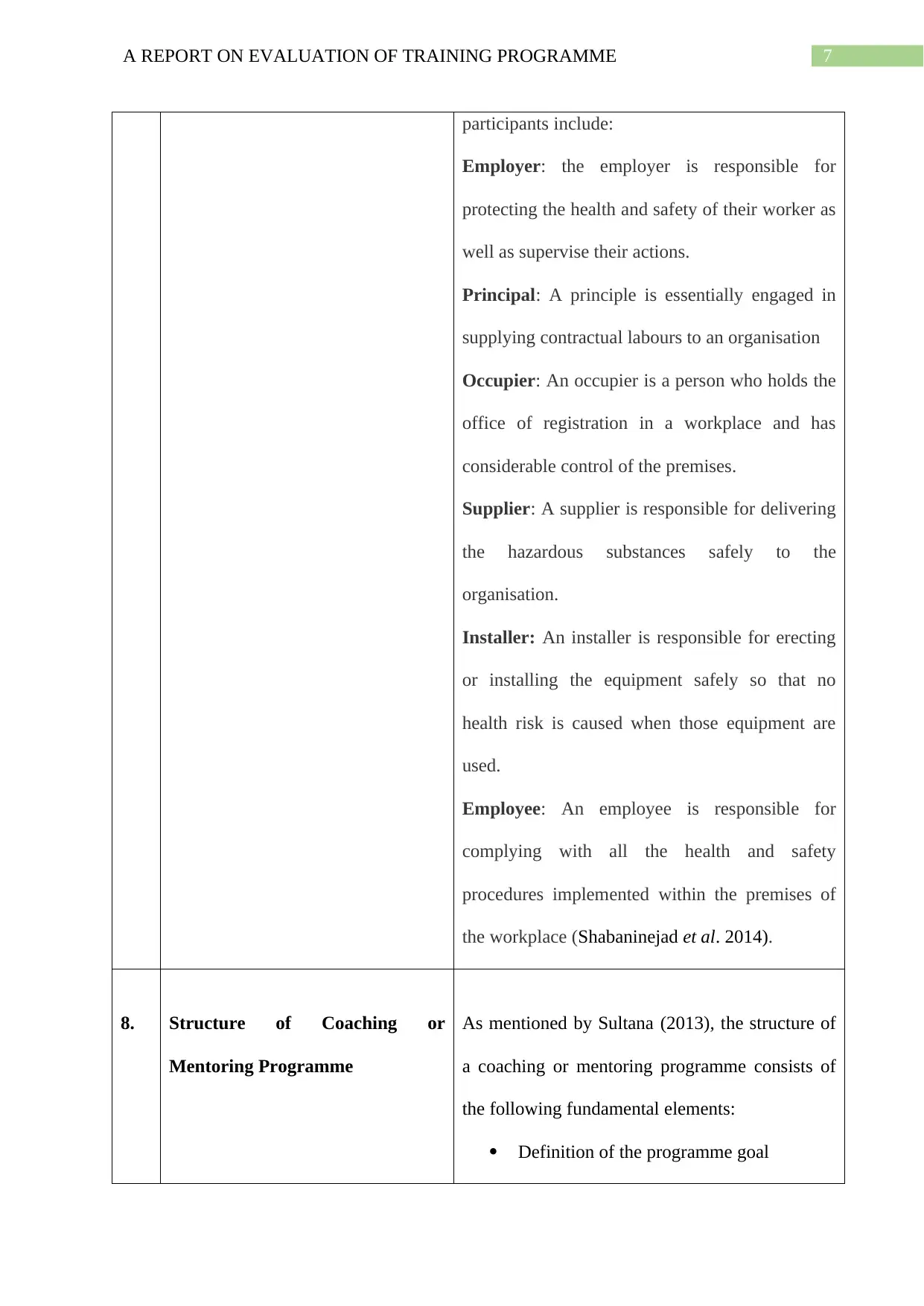
7A REPORT ON EVALUATION OF TRAINING PROGRAMME
participants include:
Employer: the employer is responsible for
protecting the health and safety of their worker as
well as supervise their actions.
Principal: A principle is essentially engaged in
supplying contractual labours to an organisation
Occupier: An occupier is a person who holds the
office of registration in a workplace and has
considerable control of the premises.
Supplier: A supplier is responsible for delivering
the hazardous substances safely to the
organisation.
Installer: An installer is responsible for erecting
or installing the equipment safely so that no
health risk is caused when those equipment are
used.
Employee: An employee is responsible for
complying with all the health and safety
procedures implemented within the premises of
the workplace (Shabaninejad et al. 2014).
8. Structure of Coaching or
Mentoring Programme
As mentioned by Sultana (2013), the structure of
a coaching or mentoring programme consists of
the following fundamental elements:
Definition of the programme goal
participants include:
Employer: the employer is responsible for
protecting the health and safety of their worker as
well as supervise their actions.
Principal: A principle is essentially engaged in
supplying contractual labours to an organisation
Occupier: An occupier is a person who holds the
office of registration in a workplace and has
considerable control of the premises.
Supplier: A supplier is responsible for delivering
the hazardous substances safely to the
organisation.
Installer: An installer is responsible for erecting
or installing the equipment safely so that no
health risk is caused when those equipment are
used.
Employee: An employee is responsible for
complying with all the health and safety
procedures implemented within the premises of
the workplace (Shabaninejad et al. 2014).
8. Structure of Coaching or
Mentoring Programme
As mentioned by Sultana (2013), the structure of
a coaching or mentoring programme consists of
the following fundamental elements:
Definition of the programme goal
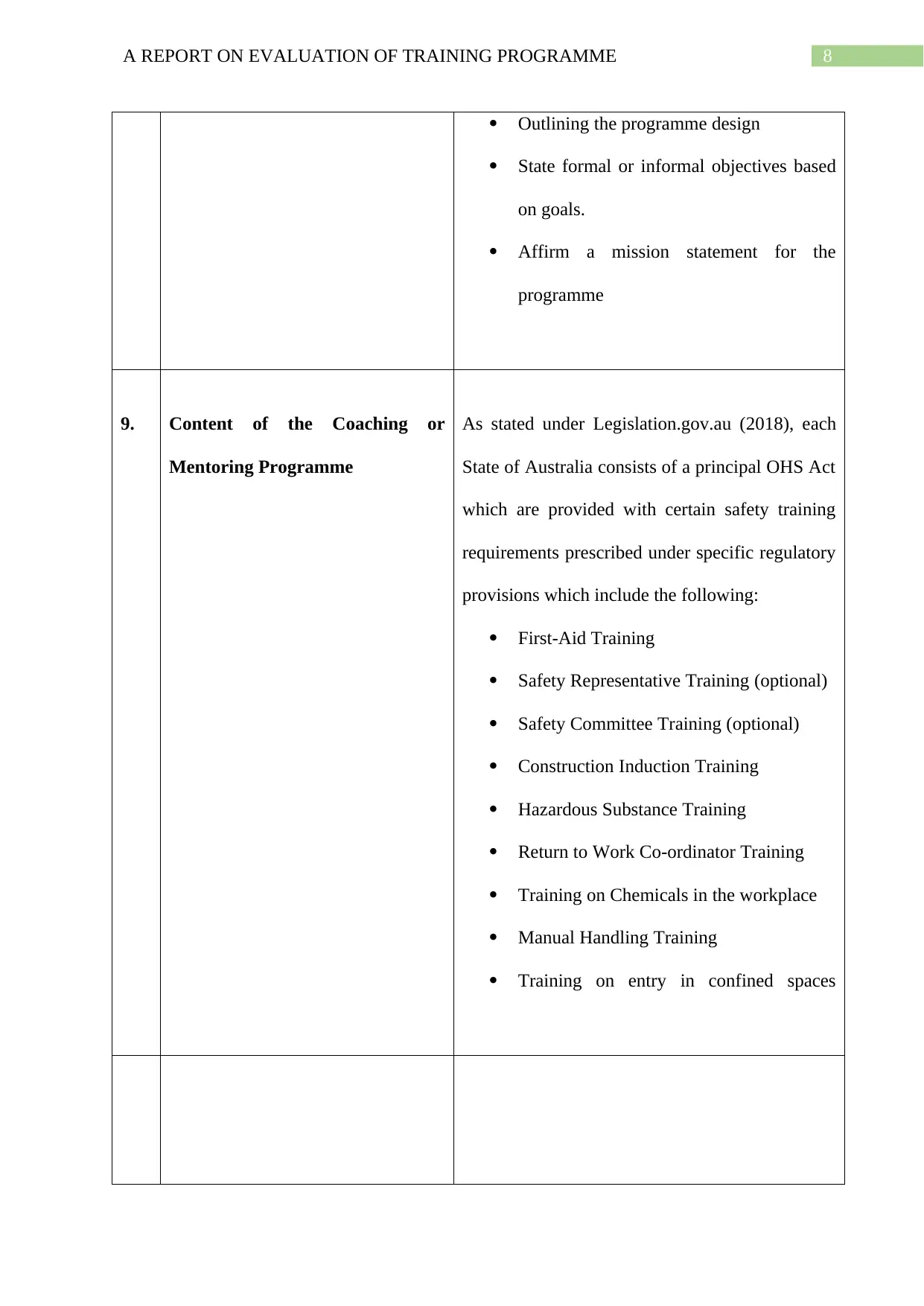
8A REPORT ON EVALUATION OF TRAINING PROGRAMME
Outlining the programme design
State formal or informal objectives based
on goals.
Affirm a mission statement for the
programme
9. Content of the Coaching or
Mentoring Programme
As stated under Legislation.gov.au (2018), each
State of Australia consists of a principal OHS Act
which are provided with certain safety training
requirements prescribed under specific regulatory
provisions which include the following:
First-Aid Training
Safety Representative Training (optional)
Safety Committee Training (optional)
Construction Induction Training
Hazardous Substance Training
Return to Work Co-ordinator Training
Training on Chemicals in the workplace
Manual Handling Training
Training on entry in confined spaces
Outlining the programme design
State formal or informal objectives based
on goals.
Affirm a mission statement for the
programme
9. Content of the Coaching or
Mentoring Programme
As stated under Legislation.gov.au (2018), each
State of Australia consists of a principal OHS Act
which are provided with certain safety training
requirements prescribed under specific regulatory
provisions which include the following:
First-Aid Training
Safety Representative Training (optional)
Safety Committee Training (optional)
Construction Induction Training
Hazardous Substance Training
Return to Work Co-ordinator Training
Training on Chemicals in the workplace
Manual Handling Training
Training on entry in confined spaces
⊘ This is a preview!⊘
Do you want full access?
Subscribe today to unlock all pages.

Trusted by 1+ million students worldwide
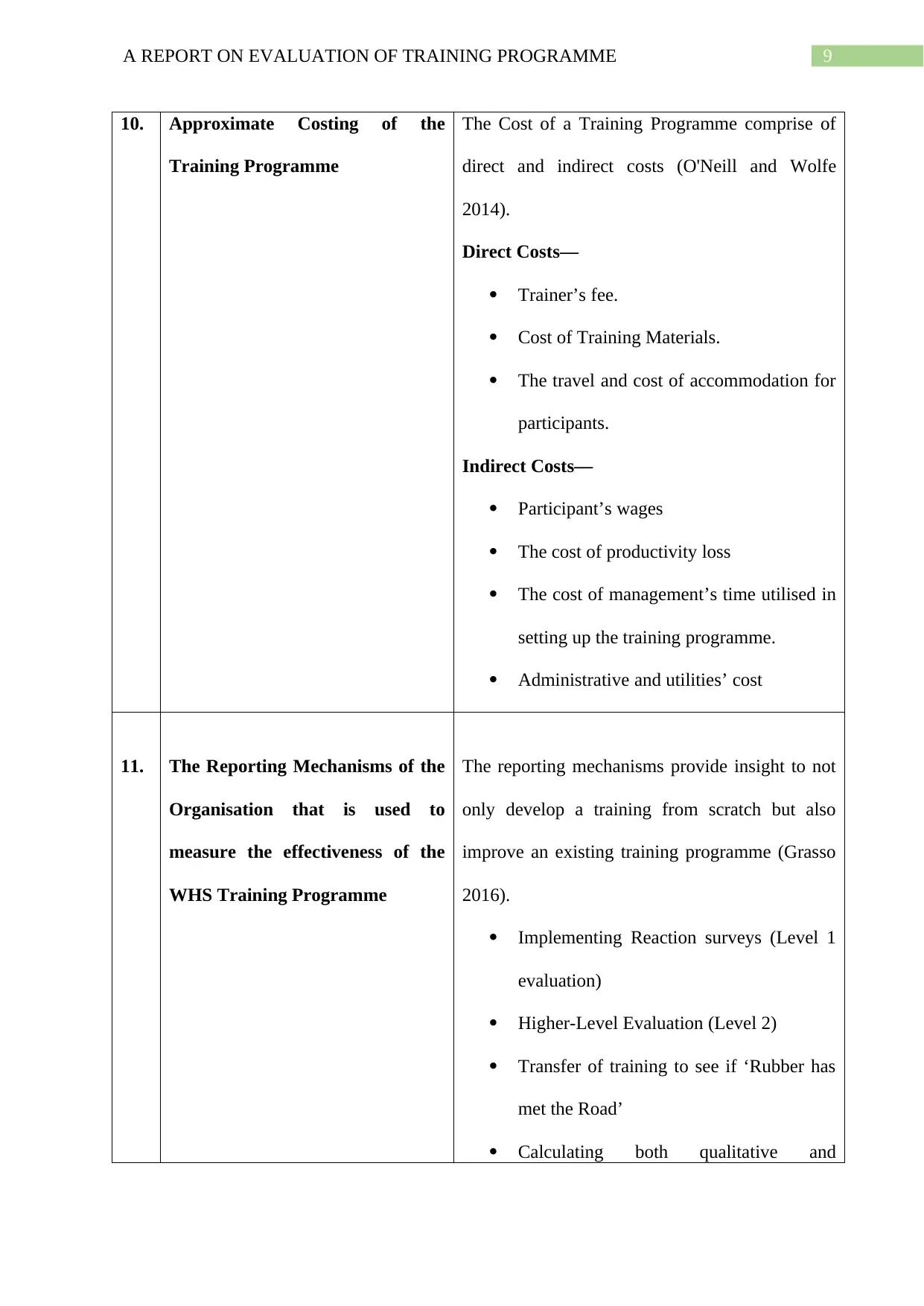
9A REPORT ON EVALUATION OF TRAINING PROGRAMME
10. Approximate Costing of the
Training Programme
The Cost of a Training Programme comprise of
direct and indirect costs (O'Neill and Wolfe
2014).
Direct Costs—
Trainer’s fee.
Cost of Training Materials.
The travel and cost of accommodation for
participants.
Indirect Costs—
Participant’s wages
The cost of productivity loss
The cost of management’s time utilised in
setting up the training programme.
Administrative and utilities’ cost
11. The Reporting Mechanisms of the
Organisation that is used to
measure the effectiveness of the
WHS Training Programme
The reporting mechanisms provide insight to not
only develop a training from scratch but also
improve an existing training programme (Grasso
2016).
Implementing Reaction surveys (Level 1
evaluation)
Higher-Level Evaluation (Level 2)
Transfer of training to see if ‘Rubber has
met the Road’
Calculating both qualitative and
10. Approximate Costing of the
Training Programme
The Cost of a Training Programme comprise of
direct and indirect costs (O'Neill and Wolfe
2014).
Direct Costs—
Trainer’s fee.
Cost of Training Materials.
The travel and cost of accommodation for
participants.
Indirect Costs—
Participant’s wages
The cost of productivity loss
The cost of management’s time utilised in
setting up the training programme.
Administrative and utilities’ cost
11. The Reporting Mechanisms of the
Organisation that is used to
measure the effectiveness of the
WHS Training Programme
The reporting mechanisms provide insight to not
only develop a training from scratch but also
improve an existing training programme (Grasso
2016).
Implementing Reaction surveys (Level 1
evaluation)
Higher-Level Evaluation (Level 2)
Transfer of training to see if ‘Rubber has
met the Road’
Calculating both qualitative and
Paraphrase This Document
Need a fresh take? Get an instant paraphrase of this document with our AI Paraphraser
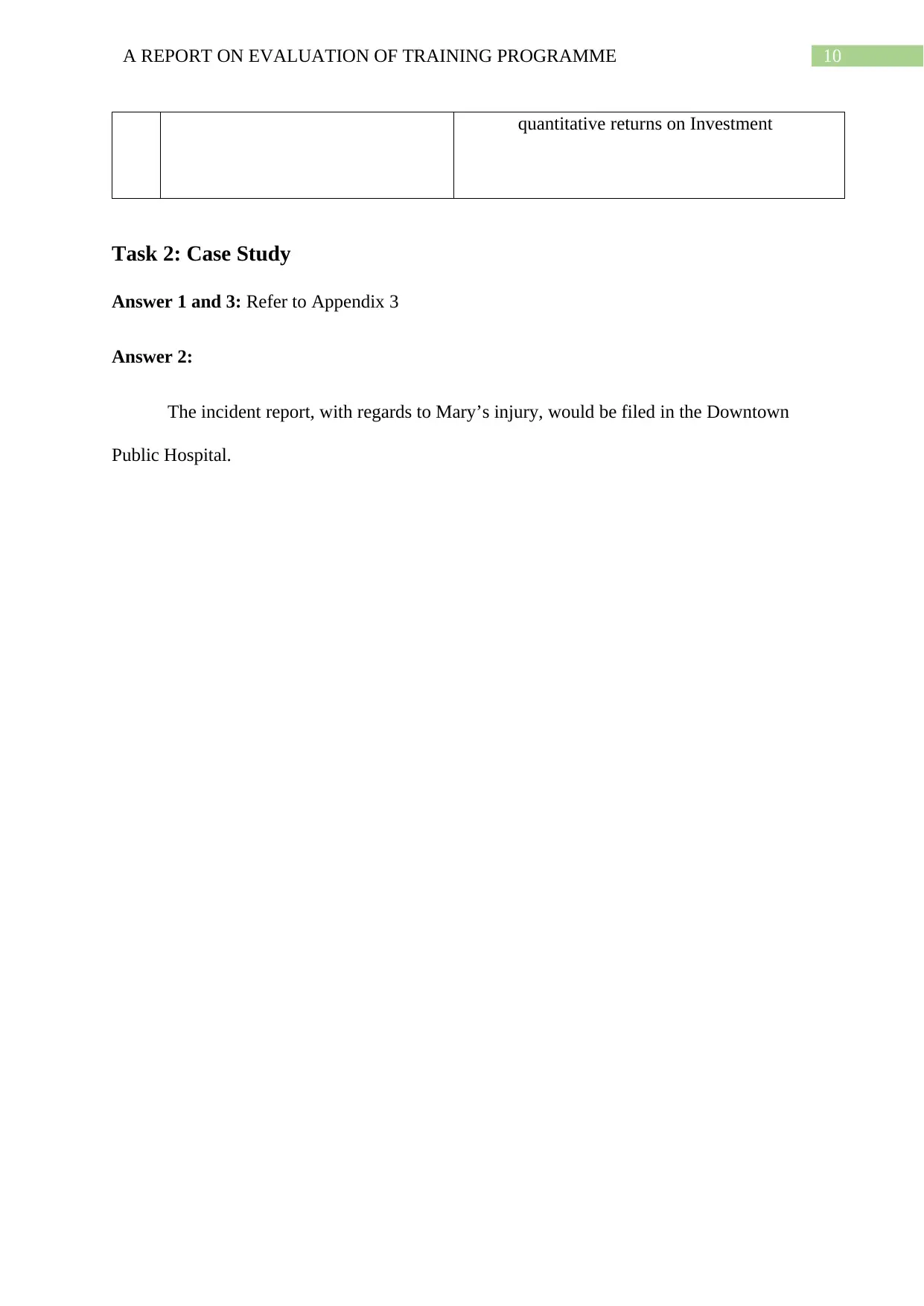
10A REPORT ON EVALUATION OF TRAINING PROGRAMME
quantitative returns on Investment
Task 2: Case Study
Answer 1 and 3: Refer to Appendix 3
Answer 2:
The incident report, with regards to Mary’s injury, would be filed in the Downtown
Public Hospital.
quantitative returns on Investment
Task 2: Case Study
Answer 1 and 3: Refer to Appendix 3
Answer 2:
The incident report, with regards to Mary’s injury, would be filed in the Downtown
Public Hospital.
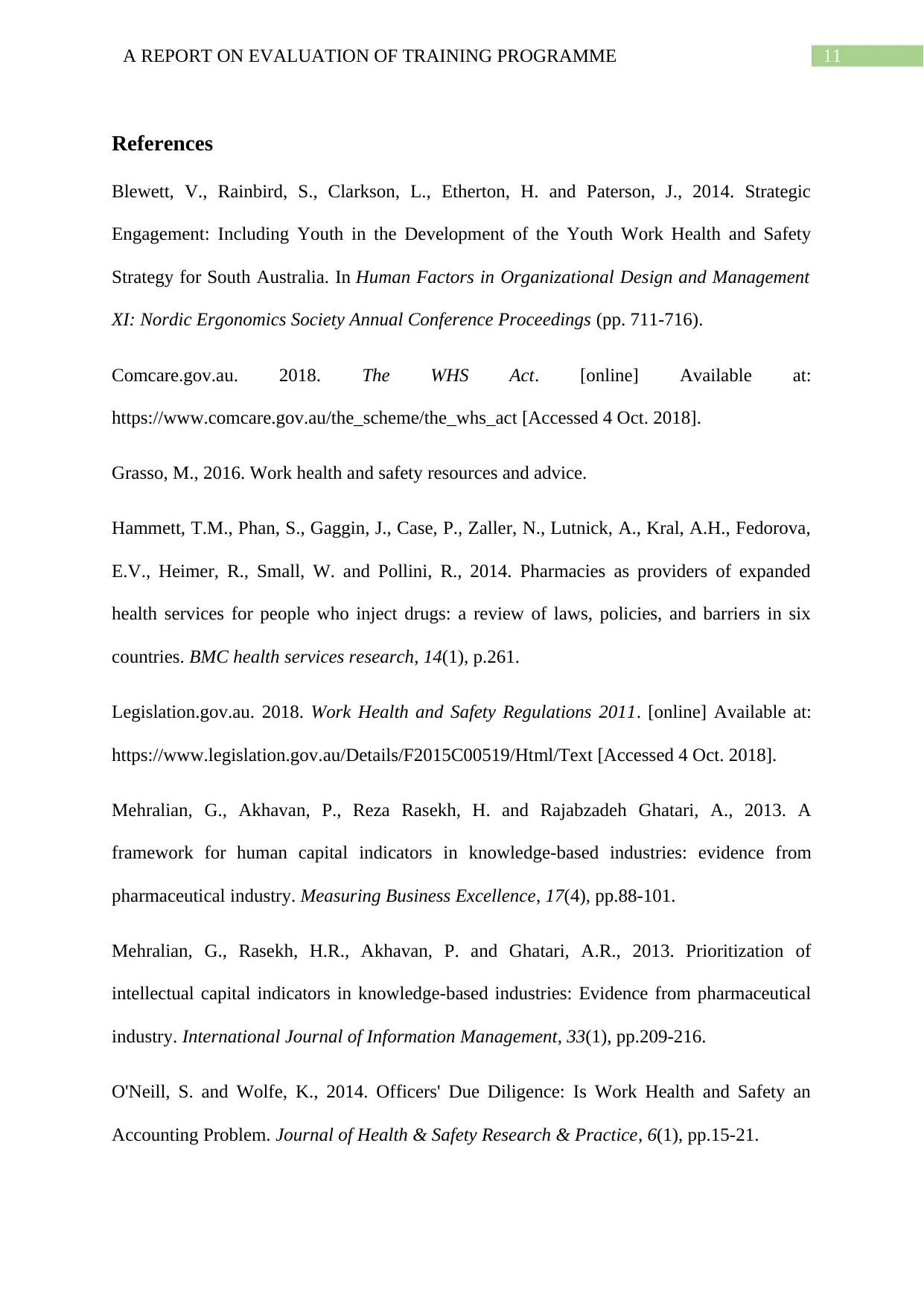
11A REPORT ON EVALUATION OF TRAINING PROGRAMME
References
Blewett, V., Rainbird, S., Clarkson, L., Etherton, H. and Paterson, J., 2014. Strategic
Engagement: Including Youth in the Development of the Youth Work Health and Safety
Strategy for South Australia. In Human Factors in Organizational Design and Management
XI: Nordic Ergonomics Society Annual Conference Proceedings (pp. 711-716).
Comcare.gov.au. 2018. The WHS Act. [online] Available at:
https://www.comcare.gov.au/the_scheme/the_whs_act [Accessed 4 Oct. 2018].
Grasso, M., 2016. Work health and safety resources and advice.
Hammett, T.M., Phan, S., Gaggin, J., Case, P., Zaller, N., Lutnick, A., Kral, A.H., Fedorova,
E.V., Heimer, R., Small, W. and Pollini, R., 2014. Pharmacies as providers of expanded
health services for people who inject drugs: a review of laws, policies, and barriers in six
countries. BMC health services research, 14(1), p.261.
Legislation.gov.au. 2018. Work Health and Safety Regulations 2011. [online] Available at:
https://www.legislation.gov.au/Details/F2015C00519/Html/Text [Accessed 4 Oct. 2018].
Mehralian, G., Akhavan, P., Reza Rasekh, H. and Rajabzadeh Ghatari, A., 2013. A
framework for human capital indicators in knowledge-based industries: evidence from
pharmaceutical industry. Measuring Business Excellence, 17(4), pp.88-101.
Mehralian, G., Rasekh, H.R., Akhavan, P. and Ghatari, A.R., 2013. Prioritization of
intellectual capital indicators in knowledge-based industries: Evidence from pharmaceutical
industry. International Journal of Information Management, 33(1), pp.209-216.
O'Neill, S. and Wolfe, K., 2014. Officers' Due Diligence: Is Work Health and Safety an
Accounting Problem. Journal of Health & Safety Research & Practice, 6(1), pp.15-21.
References
Blewett, V., Rainbird, S., Clarkson, L., Etherton, H. and Paterson, J., 2014. Strategic
Engagement: Including Youth in the Development of the Youth Work Health and Safety
Strategy for South Australia. In Human Factors in Organizational Design and Management
XI: Nordic Ergonomics Society Annual Conference Proceedings (pp. 711-716).
Comcare.gov.au. 2018. The WHS Act. [online] Available at:
https://www.comcare.gov.au/the_scheme/the_whs_act [Accessed 4 Oct. 2018].
Grasso, M., 2016. Work health and safety resources and advice.
Hammett, T.M., Phan, S., Gaggin, J., Case, P., Zaller, N., Lutnick, A., Kral, A.H., Fedorova,
E.V., Heimer, R., Small, W. and Pollini, R., 2014. Pharmacies as providers of expanded
health services for people who inject drugs: a review of laws, policies, and barriers in six
countries. BMC health services research, 14(1), p.261.
Legislation.gov.au. 2018. Work Health and Safety Regulations 2011. [online] Available at:
https://www.legislation.gov.au/Details/F2015C00519/Html/Text [Accessed 4 Oct. 2018].
Mehralian, G., Akhavan, P., Reza Rasekh, H. and Rajabzadeh Ghatari, A., 2013. A
framework for human capital indicators in knowledge-based industries: evidence from
pharmaceutical industry. Measuring Business Excellence, 17(4), pp.88-101.
Mehralian, G., Rasekh, H.R., Akhavan, P. and Ghatari, A.R., 2013. Prioritization of
intellectual capital indicators in knowledge-based industries: Evidence from pharmaceutical
industry. International Journal of Information Management, 33(1), pp.209-216.
O'Neill, S. and Wolfe, K., 2014. Officers' Due Diligence: Is Work Health and Safety an
Accounting Problem. Journal of Health & Safety Research & Practice, 6(1), pp.15-21.
⊘ This is a preview!⊘
Do you want full access?
Subscribe today to unlock all pages.

Trusted by 1+ million students worldwide
1 out of 16
Related Documents
Your All-in-One AI-Powered Toolkit for Academic Success.
+13062052269
info@desklib.com
Available 24*7 on WhatsApp / Email
![[object Object]](/_next/static/media/star-bottom.7253800d.svg)
Unlock your academic potential
Copyright © 2020–2025 A2Z Services. All Rights Reserved. Developed and managed by ZUCOL.




